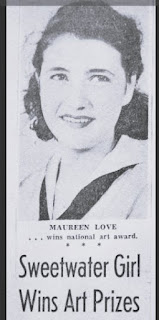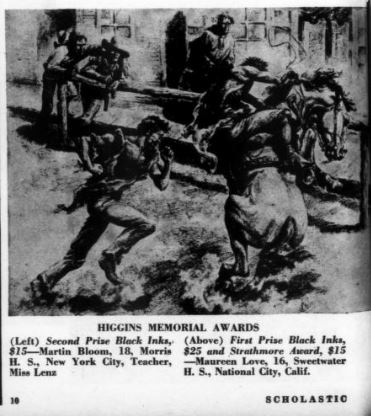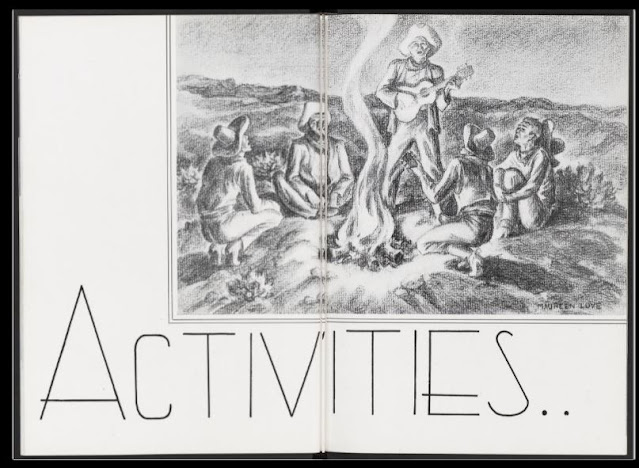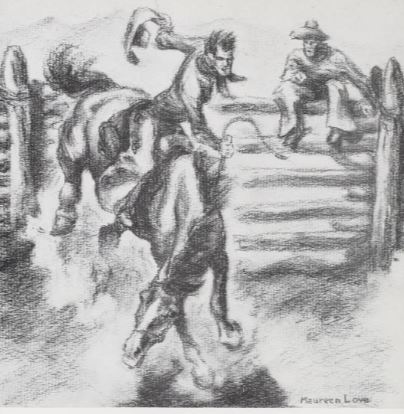There's an old expression, "Never look a gift horse in the mouth." You can estimate the age of a horse by looking at its teeth, so to "look it (a gift horse) in the mouth" would be to scrutinize and criticize the gift.
As I've noted some of in my previous blog posts, the combination of Arabian horses and Hollywood film stars of the 1920s often led to some dubious and/or exaggerated claims about Arabians in the press.
Now we're going to look a gift horse BOOK in the mouth, so to speak, and try to identify a particular horse book that has quite a backstory. And we can do that without guilt, because the book was not given as a gift to us. It was a present from one very famous man to another.
A colleague recently asked me to look into newspaper articles published between late 1927 and mid-1928, that said that cowboy actor Tom Mix had given a very special horse book to cereal magnate and Arabian horse breeder W. K. Kellogg.
Let's pause for some context before we explore the book itself. Kellogg used the might of his cereal company's advertising agency, N. W. Ayer & Son, as well as members of the ranch's staff and publicist Earl H. "Spide" Rathbun (1886-1961) (who had Hollywood connections) to tell the tale of the Kellogg Arabians. The Kellogg Arabians had a special mystique; the Kellogg Ranch's proximity to, and connection with, Hollywood was a very important part of this public image.
 |
| Tom Mix and his (not Arabian) horse, Tony. |
The first newspaper article that tells the tale of Tom Mix's gift was in the December 14, 1927, edition of the Pomona Progress-Bulletin.
The paper published a long and rather flowery story quoting Spide Rathbun about a variety of activities at the new Kellogg Arabian Horse Ranch in Pomona. Several well-known pilots had recently flown their biplane to an alfalfa patch at the Kellogg Ranch, saying it would make a good place for "a first-class landing field." Future tourists, Rathbun said, would be able to drive or fly directly to the Ranch. (The landing strip operated from 1928 to 1932.)
The Kellogg Ranch, the article continued, was a "True 'Show Place,' a mecca for sightseers, situated in a little valley of its own surrounding [sic] by gentle, undalating [sic] hills." --
.jpg) |
 |
Note the publication date: 1737. This is an important clue about the real nature of the unidentified book.
The publicity blitz for the Kellogg Ranch continued a couple of weeks later, with a large photo spread and some articles in the Progress-Bulletin's December 31, 1927 edition.
The photographs, by the Frasher studio, showed humorist Will Rogers on the stallion Letan, starlet Laura LaPlante with Mr. Kellogg and the stallion Antez; Mr. Kellogg with his dog Rinson, a son of canine film star Rin-Tin-Tin, and more.
A sidebar article expands on the nature of the book given to Mr. Kellogg by Tom Mix.
"As a result of a visit by Tom Mix, the well known cowboy of the silver screen, has presented Mr. Kellogg with a valuable book published in France in 1727 which contains one of the most complete histories of early Arabian horses in the world. The book is 28 inches long and 16 inches wide and three inches thick. It is full of interesting reading matter about Arabians in French, the full translation of which has not been completed. [As we will shortly see, there already was an English translation, but presumably Rathbun didn't know that.] A marvelous collection of wood cuts and engravings of Arabian horses are numerous in the book. It it one of the feature exhibits shown visitors to the ranch."
Note that the stated publication date of the book has been pushed back from 1737 to 1727.
A rewritten version of the article appeared in the March 16, 1928 edition of the Battle Creek, Michigan Moon-Journal. (Battle Creek was the home of Kellogg's cereal empire.) It noted that the book was 200 years old, and dropped a number of celebrity names at the end, including Valentino, humorist and horseman Will Rogers, and others.
To summarize, the newspaper articles don't tell us the name of the book nor that of its author. We know that it was quite large, written in French, published in either 1727 or 1737, and on display at the time at the Kellogg Ranch.
But we do know what some of the book's pages looked like! The W. K. Kellogg Arabian Horse Library at Cal Poly Pomona (on the old Kellogg Ranch property) collection contains two photographs of interest, which were recently on display at the library. (Thus the glare from the display case in the picture I took.)
One 8x10" print shows a two-page spread (one image that covers two adjacent pages) from the book Tom Mix gave to Mr. Kellogg. The second photo shows the glass "cage" that housed the Valentino and Jadaan costumes, other costumes and tack, and (in the lower left corner) the rare book given to Mr. Kellogg by Tom Mix. The book is open to a different two-page spread.
Mary Jane Parkinson reprinted the second image in her classic book The Romance of the Kellogg Ranch.
 |
 |
Both of these images were indeed published in the same book, but it wasn't about Arabian horses.
The inscription in the upper left corner in the first photograph tells us that the rider is "Charles Second, Roy de la Grande Bretagne" -- Charles II, King of Great Britain. The notes at the bottom tell us he is surrounded by the gods Cupid, Mars, and Mercury.
And the building in the background of the second photograph, thank you Internet search engines, is Bolsover Castle (with the tiny word "Bolsouer" inscribed to its right) in Derbyshire. It was owned by the highly influential horseman William Cavendish, the first Duke of Newcastle (1592 - 1676).
And now we can find the name of the large book, written in French, published in 1737, that Tom Mix gave to W. K. Kellogg in 1927. Both of these images are in Cavendish's monumental book La Methode et Invention nouvelle de Dresser les Chevaux (Method and New Way to Train Horses), first published in French, around 1657-1658.
The National Sporting Library and Museum in Virginia owns a copy. They summarize it thus:
The volume, written by William Cavendish (1592-1676), the first duke of Newcastle, was published in 1657 in Antwerp, where the Royalist general lived in political exile during the Commonwealth period.
According to a bibliography by Richard von Hunersdorff, the folio-sized volume, published in French from an English manuscript, is illustrated with 42 double-page engravings by Abraham van Diepenbeeck, a Dutch painter of the Flemish school who was a student and assistant of Peter Paul Rubens. The engravings depict a variety of scenes: hunting scenes set at [Cavendish's] estates at Welbeck and Bolsover Castle, his stud farm, and figurative scenes showing the duke worshiped by his horses with the gods of Olympus watching in amazement.
To be fair, the National Sporting Library & Museum blog continues, William Cavendish’s self-confidence was warranted: he trained in Naples and was the only English master of the High School of Riding. In addition, he taught the young Charles Stuart and his cousin, Prince Rupert and trained them to be accomplished horsemen. Cavendish returned to England, where King Charles II awarded the general a dukedom for his loyalty.
(I'll let you look up this period in British history on your own.)
Importantly, Cavendish's book was reprinted in 1667, 1737, and 1743. So now we have the publication date, the name of the book, the author, and the illustrator!
But was this, as the newspaper articles stated, a book about Arabian horses? Not really.
However, it does have at least a dotted line connection to Arabian horses. Sources tell us that Cavendish established a riding school in Antwerp with several "Barbary horses" he bought in Paris, and that he very much liked his Barbs. "Barb" refers to a breed of riding horses with historic roots in North Africa, similar to Arabians but with some different physical characteristics.
The Methode book briefly mentions Barbs and Arabians. The 1743 posthumous English translation, for example, includes Cavendish's observation that the "beft [best] Race in England comes from the Barbary and Arabian Horfes [horses]; and thefe [these] are certainly the fineft [finest] Creatures in the World for the Saddle, if they are not fpoiled [spoiled] when young."
One of the illustrations shows a horse called "Paragon un Barbe," with what appears to be an African handler, at Cavendish's Welbeck Abbey property. (I wonder if the white patches on Paragon's coat are roan or rabicano markings?)
Paragon, with his white markings, seems to be the horse on the right on the title page of the book, too:
 |
So I believe that, contrary to published reports, the book in the glass case at the old Kellogg Ranch, given to Mr. Kellogg by Tom Mix, was not really a "bible" of Arabian horse information.
Rather, it appears to have been a copy of the 1737 edition of William Cavendish's classic treatise on horsemanship, Methode et Invention Nouvelle de Dresser les Chevaux.
But why was the book, given to W. K. Kellogg by Tom Mix, described as being an "Arabian horse bible," and "one of the most complete histories of early Arabian horses in the world"?
I don't know. It's possible that publicist Rathbun and/or someone else at the Kellogg Ranch assumed the book was about Arabians and didn't read French well enough to double-check. Perhaps they leafed carefully through the book, saw the words "Barbe" and "Arabe," and assumed the entire volume was about Arabians?
Or perhaps it just made a really good newspaper story that enhanced the mystique of the Kellogg Ranch?
Regardless of the motivation behind the news reports, Cavendish's important work does contain a few observations by an Englishman (albeit originally published in French) in the mid-1600s about Arabian horses, Barbs, Turkish horses, and other breeds.
W. K. Kellogg wanted his horse ranch to become an important repository of Arabian horse history. And indeed, the W. K. Kellogg Arabian Horse Library at Cal Poly Pomona is now one of the world's largest publicly available collections on the Arabian horse. (Based on my perusal of the Cal Poly Pomona online library catalog, the 1737 book is not now at the Kellogg Arabian Horse Library or in the collection of the larger University Library, more's the pity.)
I'll keep looking for more information!
____
Bless their hearts, the NSLM digitized their copy of Cavendish's book; it's available on the Internet Archive website, and is in the public domain. You'll need a free account to see it:
https://archive.org/details/methode-et-invention-nouvelle-de-dresser-les-chevavx-1658/mode/2up
You can also find digitized public domain copies there of the two volume 1743 English translation of the book, under the title A General System of Horsemanship in All It's [sic] Branches.
Volume I: https://archive.org/details/a-general-system-of-horsemanship-1743/mode/2up
Volume II: https://archive.org/details/a-general-system-of-horsemanship-in-all-its-branches-v2/mode/2up
Here is the NSLM blog post about the original edition:
The British Royal Collection Trust owns a copy of the 1737 edition: https://www.rct.uk/collection/1070974/methode-et-invention-nouvelle-de-dresser-les-chevaux-par-le-tregraves-noble-haut
Paragon the Barb appears in this list of Thoroughbred Foundation Sires:
https://tbheritage.com/HistoricSires/FoundationSires/FoundSiresChron.html
The English Heritage website describes Bolsover Castle as "the creation of a horse-mad Cavalier playboy." Here's a drone video; perhaps Bolsover would be a good addition to your next horse-themed Road Trip:
https://www.youtube.com/watch?v=D_cYfPjxTxA&t=13s
And here's Welbeck Abbey: https://www.welbeck.co.uk/the-welbeck-estate/about-us/our-heritage/
Tom Mix and Tony the Wonder Horse:
https://www.youtube.com/watch?v=WTCn3jyZ4wM
The W. K. Kellogg Arabian Horse Library:
"The W.K. Kellogg Arabian Horse Library (WKKAHL) is one of the world's largest publicly available collections on the Arabian horse and is a part of the Special Collections and Archives unit. Learn more about the history of and resources available at the WKKAHL in our research guide" :
https://libguides.library.cpp.edu/wkkahl



.jpg)











































